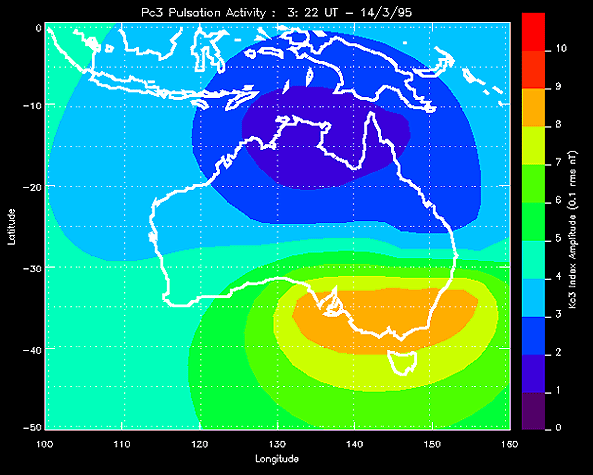Geomagnetic Pulsations in Aeromagnetic Surveys
Variations of the Earth's magnetic field due to solar-terrestrial interaction are often used for geomagnetic soundings to study the Earth's conductivity. Such geomagnetic field variations are categorized by their period and structure into classes (Figure 1); Pc1 to Pc5 for continuous structured pulsations, and Pi1 and Pi2 for irregular structures (For further information on geomagnetic pulsation classes and their properties refer to Jacobs, 1970; Orr, 1973; Anderson et al., 1990; Takahashi, 1991; Allan and Poulter, 1992). However, these fluctuations of the geomagnetic field may also cause unwanted background noise for magnetic exploration surveys used to delineate buried targets of potential economic importance.

Figure 1: Nomenclature for the natural geomagnetic field fluctuations. Amplitudes depicted in the figure are typical sizes to be expected for moderate activity at mid-latitude locations. The "continuous" pulsation, Pc1-5, nomenclatures are assigned the period ranges indicated near the peak amplitude positions. The "irregular" pulsation, Pi 1&2, are identified with their period ranges at the bottom (from Campbell, 1997).
Temporal variations of the Earth's magnetic field, such as magnetic storms, diurnal variations and geomagnetic pulsations, all present problems when interpreting magnetic survey data. Magnetic storms cause considerable disruption to magnetic prospecting due to the unpredictable and irregular nature of the geomagnetic field oscillations. It is usually not feasible to correct for these, as is often done for the more regular diurnal variations. Furthermore, survey specifications typically stipulate conditions "unfit for survey" as a non-linear change of 5 nT in 5 minutes or 10 nT in 10 minutes, for example. These conditions are regularly observed during magnetic storms and hence surveys must generally be discontinued during storms of any severity. Presently, the ASWFC solar and geophysical reports are used by survey contractors to warn of impending magnetic storm conditions.
Petroleum exploration surveys have more stringent requirements that the ground magnetic trace deviation does not exceed 2 nT over any 2 minute interval, in order for the survey data to be acceptable. Further, these surveys require a precision of better than 1 nT (Redford, 1979). Such amplitudes and periods are typical of geomagnetic pulsations in the Pc3/4 range over the Australian region. In addition, recent developments in instrumentation have made possible the definition of small, high frequency magnetic responses that may be related to very small changes (as low as 0.1 nT) in the magnetic character of near-surface sediments (Paterson and Reeves, 1985). In these situations, geomagnetic pulsations constitute a definite source of noise.
It is the intention of Bureau of Meteorology - Space Weather Services to extend the current ASWFC solar and geophysical reports to include real-time and forecast geomagnetic pulsation information to geophysics customers. The information is envisaged to be provided in the form of regional contour maps generated from pulsation indices (Figure 2). These maps used in conjunction with conductivity maps should provide a reasonable estimate of current and future geomagnetic pulsation activity levels.

Figure 2: An example regional contour map of Pc3 pulsation indices generated from data recorded at seven stations. Such maps may be used in conjunction with conductivity maps to provide a reasonable representation of Pc3 pulsation activity levels.
References
Allan W. and Poulter E.M.: ULF waves - their relationship to the structure of Earth's magnetosphere, Rep. Prog. Phys., 55, p533, 1992.
Anderson B.J., Engerbretson M.J., Zanetti S.P. and Potemra T.A.: A statistical study of Pc3-5 pulsations observed by the AMPTE/CCE magnetic field experiment, 1. Occurrence distributions, J. Geophys. Res., 95, p10495, 1990.
Campbell, W. (1997). Introduction to Geomagnetic Fields. Cambridge: Cambridge University Press.
Jacobs J.A.: Geomagnetic micropulsations, Springer-Verlag, New York, 1970.
Orr D.: Magnetic pulsations within the magnetosphere: A review, J. Atmos. Terr. Phys., 35, p1, 1973.
Paterson J.R. and Reeves C.V.: Applications of gravity and magnetic surveys: The state-of-the-art in 1985, Geophysics, 50, p2558, 1985.
Redford M.S., in Lanzerotti L.J., Kennel C.F. and Parker E.N., Eds.: Problems of magnetic fluctuations in geophysical exploration, Solar system plasma physics, 3, North Holland Publ. Co., p365, 1979.
Takahashi K.: ULF waves in the magnetosphere, Rev. Geophys., Supplement, p1066, 1991.
Material prepared by Richard Marshall.





